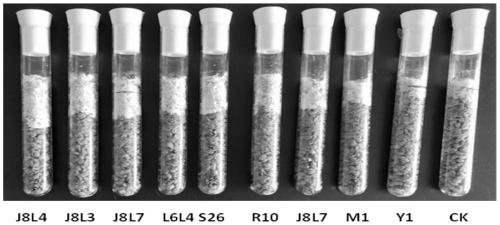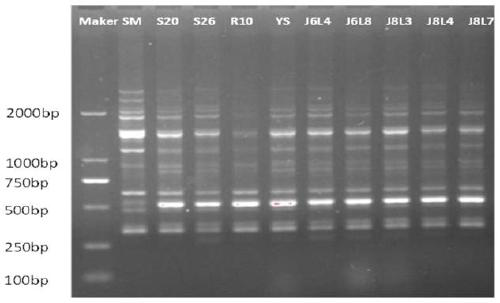High-temperature-resistance stropharia rugosoannulata strain and application thereof
A high-temperature-resistant technology for large stropharia, applied in applications, fungi, fungal products, etc., can solve problems such as low temperature resistance, easy opening of umbrellas, early fruiting, etc., to improve high-temperature resistance and high promotion and application value Effect
- Summary
- Abstract
- Description
- Claims
- Application Information
AI Technical Summary
Benefits of technology
Problems solved by technology
Method used
Image
Examples
Embodiment 1
[0055] Embodiment 1: Breeding and identification of high temperature-resistant Stropharia stropharia
[0056] 1. Parent selection:
[0057] High-yielding Stropharia stropharcoides strains S26 (early fruiting, high yield) and R10 (high proportion of first-grade mushrooms, not easy to open umbrellas) were bred by the Key Laboratory of Microbiology of Shandong Agricultural University.
[0058] 2. Obtain spores:
[0059] In the experimental field, choose fruiting bodies with the first tidal fruiting, eight mature mushrooms, neat growth, dignified mushroom shape, short primordium emergence time, thick cap, and thick and long stipe.
[0060] In the ultra-clean workbench, cut off the stipe of the picked fruiting bodies suitable for use as parents, and discard them. Place the gills downward in a sterile petri dish for 24 hours to obtain spore prints. Then take out the cap, cover the Petri dish, mark the name of the bacterial strain, seal it with plastic wrap, and keep the spore pri...
Embodiment 2
[0128] Embodiment 2: the cultivation of high temperature resistant stropharia
[0129] 1. Preparation of stock species
[0130] Inoculate the activated high-temperature-resistant Stropharia stropharia Shannong No. 3 strain into the parent medium, and culture it at a constant temperature of 26°C for 15 days.
[0131] 2. Preparation of Liquid Strains
[0132] Inoculate the mother species into Erlenmeyer flasks with 100 mL of sterile liquid medium, inoculate 7 bacteria cakes with a diameter of 5 mm in each bottle, and place them in a constant temperature shaker at 26 °C at 160 r / min for 7 days.
[0133] 3. Preparation of Stock Seeds
[0134] Weigh an appropriate amount of wheat grains, add 2% quicklime to soak for 12 hours, remove and rinse for 1 to 2 times, then boil on high heat until most of the grains are transparent and free of white cores, then immediately pour into cold water for cooling. Drain excess water, add 2% wheat bran and 2% gypsum and mix well. Use the origina...
Embodiment 3
[0149] Embodiment 3: fruiting test
[0150]The high-temperature-resistant strains screened out through single-spore cross-breeding, high-temperature-resistant domestication, primary screening, and re-screening were verified by indoor antagonism tests and subculture methods to obtain a total of 8 high-temperature-resistant strains (J8L4, J8L3, J8L7, J6L8, J6L4 , M1, Y1, L20), it is carried out cultivation test (cultivation method is the same as embodiment 2), with SM (national certification variety), S26 (departure bacterial strain) and R10 (departure bacterial strain) as contrast.
[0151] Experiment 1: Mushrooming in spring greenhouse
[0152] On September 15, 2018, the material was sown in the spring warm greenhouse, and the ground temperature was 26°C during cultivation. After the cultivation, install the air and soil temperature sensors in time, measure the temperature in the spring warming shed, record the temperature data every hour, and make the ground temperature and ...
PUM
| Property | Measurement | Unit |
|---|---|---|
| Thickness | aaaaa | aaaaa |
Abstract
Description
Claims
Application Information
 Login to View More
Login to View More - R&D
- Intellectual Property
- Life Sciences
- Materials
- Tech Scout
- Unparalleled Data Quality
- Higher Quality Content
- 60% Fewer Hallucinations
Browse by: Latest US Patents, China's latest patents, Technical Efficacy Thesaurus, Application Domain, Technology Topic, Popular Technical Reports.
© 2025 PatSnap. All rights reserved.Legal|Privacy policy|Modern Slavery Act Transparency Statement|Sitemap|About US| Contact US: help@patsnap.com



